earthquake
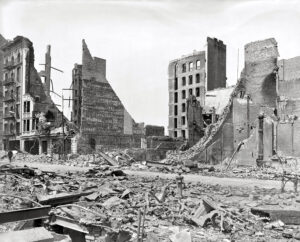 On April 18, 1906, many of the people in the San Francisco, California area were sound asleep in their beds. It was, after all, 5:13am. Suddenly, the people were jolted awake by an earthquake, which was estimated to be close to 8.0 on the Richter scale. When the quake struck San Francisco, California, it toppled numerous buildings. The cause of the quake was a slip of the San Andreas Fault over a segment about 275 miles long. The resulting shock waves could be felt from southern Oregon down to Los Angeles.
On April 18, 1906, many of the people in the San Francisco, California area were sound asleep in their beds. It was, after all, 5:13am. Suddenly, the people were jolted awake by an earthquake, which was estimated to be close to 8.0 on the Richter scale. When the quake struck San Francisco, California, it toppled numerous buildings. The cause of the quake was a slip of the San Andreas Fault over a segment about 275 miles long. The resulting shock waves could be felt from southern Oregon down to Los Angeles.
At that time, San Francisco’s had a variety of brick buildings and wooden Victorian structures that were not really earthquake reinforced. Nobody knew about making buildings strong enough to resist destruction from an earthquake. It was one of the things we would learn from the results of a disaster. It seems that with each disaster, we learn how to prevent the loss of so many buildings and lives. The old buildings were devastated. Along with the collapsed buildings, came devastating fires, and because many of the water mains had broken, firefighters were prevented from stopping 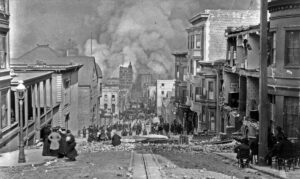 the fires. Firestorms soon developed citywide. US Army troops from Fort Mason reported to the Hall of Justice around 7am, and San Francisco Mayor E.E. Schmitz set a dusk-to-dawn curfew and authorized soldiers to shoot to kill anyone found looting. Disasters like these always seem to bring out the worst in people, even those who might not have done such things under normal circumstances.
the fires. Firestorms soon developed citywide. US Army troops from Fort Mason reported to the Hall of Justice around 7am, and San Francisco Mayor E.E. Schmitz set a dusk-to-dawn curfew and authorized soldiers to shoot to kill anyone found looting. Disasters like these always seem to bring out the worst in people, even those who might not have done such things under normal circumstances.
As significant aftershocks continued, firefighters and US troops fought desperately to control the ongoing fires. Sadly, that sometimes meant dynamiting whole city blocks to create firewalls. Many people were trapped where they were, because the fires prevented their escape, even though they were not stuck in a collapsed building. Finally, on April 20th, several thousands of refugees were evacuated from the foot of Van Ness Avenue. The army would eventually house 20,000 refugees in more than 20 military-style tent camps across the city. The people had no idea how long they might have to be there.

Most of the fires were extinguished by April 23rd, and the authorities started the task of rebuilding the devastated city. In all, approximately 3,000 people lost their lives as a result of the Great San Francisco Earthquake and the devastating fires it inflicted upon the city. Almost 30,000 buildings were destroyed, including most of the city’s homes and nearly all the central business district. The rebuilding would take a long time, and the new structures were reinforced to be able to better withstand the shaking of the San Andreas fault. This quake may not have been the “Big One” that is predicted, but at an estimated 7.9 or 8.0, it was right up there.

 These days, we have early warning alarms for tornadoes, floods, hurricanes, and even tsunamis, but on July 21, 365, no such warnings existed, not did any kind of measuring tools so we could know the magnitude of the earthquake that caused tsunamis, or the height of the tsunami itself. Nevertheless, it is known that a powerful earthquake off the coast of Greece caused a tsunami that devastated the city of Alexandria, Egypt.
These days, we have early warning alarms for tornadoes, floods, hurricanes, and even tsunamis, but on July 21, 365, no such warnings existed, not did any kind of measuring tools so we could know the magnitude of the earthquake that caused tsunamis, or the height of the tsunami itself. Nevertheless, it is known that a powerful earthquake off the coast of Greece caused a tsunami that devastated the city of Alexandria, Egypt.
In spite of the lack of measuring tools at the time, scientists can now estimate that the earthquake was actually two quakes in quick succession. It is estimated that the largest of those quakes was about a magnitude of 8.0. That magnitude of quake is massive by any standards, and it must have been very scary for anyone who might have felt it. It’s hard to say how many people actually felt it, because of its oceanic location, but even if no one felt the quake, they very much felt the aftereffects of that quake. The really tragic thing was that they had no idea what was coming their way, how very dangerous it was, or even that they should run when they saw it coming. I’m sure that they had seen tides come in and go out, and even storms bringing big wave onto the shore. So, it is very possible that they thought this was not that different than those things, except for it not being time for the tide and there was no storm. They likely just stood there looking at this strange phenomenon, until it took them all out.
The quake was centered near a plate boundary called the Hellenic Arc. Following the quake, a wall of water ran across the Mediterranean Sea toward the Egyptian coast. As happens in tsunamis, the water first recedes, and then comes crashing back. As the water in the harbor receded, ships docked at Alexandria suddenly overturned. As often happens in a disaster, it was reported that many people rushed out to loot the overturned ships. That put even more people in harm’s way. The tsunami wave then rushed in and carried the ships over the sea walls, landing many on top of buildings. The people were trapped, and in Alexandria alone, on that one day, approximately 5,000 people lost their lives, and 50,000 homes were destroyed.
The destruction was even greater in the surrounding villages and towns. Many of these small villages were literally wiped of the face of the earth. Outside of Alexandria, 45,000 people were killed. The salty sea water, inundation the farmlands, rendering them useless for years. From what scientists are able to piece together, the area’s shoreline was permanently changed by the disaster. The tsunami continued on, slowly, but steadily 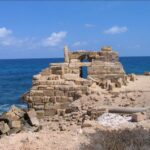
 overtaking the buildings of Alexandria’s Royal Quarter. The main reason that the archaeologists learned about this horrific event was that in 1995 that archaeologists actually discovered the ruins of the old city, which lies off the coast of present-day Alexandria. With the changed shoreline following the tsunami, many of the old buildings remained under water for centuries.
overtaking the buildings of Alexandria’s Royal Quarter. The main reason that the archaeologists learned about this horrific event was that in 1995 that archaeologists actually discovered the ruins of the old city, which lies off the coast of present-day Alexandria. With the changed shoreline following the tsunami, many of the old buildings remained under water for centuries.
 I suppose that if I lived in Quebec, Canada, I might have heard the Abitibi-Témiscamingue region and maybe even the Western Quebec Seismic Zone. Since I don’t, these areas are new to me. Maybe they were new to a lot of people, but on November 1, 1935, a lot more people knew about them. On that day, a 6.1 magnitude earthquake with a maximum Mercalli intensity of VII (Very strong) occurred. The epicenter occurred on a thrust fault in the Timiskaming Graben, a little over 6 miles northeast of Témiscamingue, at about 1:03am ET.
I suppose that if I lived in Quebec, Canada, I might have heard the Abitibi-Témiscamingue region and maybe even the Western Quebec Seismic Zone. Since I don’t, these areas are new to me. Maybe they were new to a lot of people, but on November 1, 1935, a lot more people knew about them. On that day, a 6.1 magnitude earthquake with a maximum Mercalli intensity of VII (Very strong) occurred. The epicenter occurred on a thrust fault in the Timiskaming Graben, a little over 6 miles northeast of Témiscamingue, at about 1:03am ET.
While the earthquake was in Canada, it was felt over a wide area of North America, extending west to Fort William (now Thunder Bay), east to Fredericton, New Brunswick, north to James Bay and south as far as Kentucky and West Virginia. Occasional aftershocks were reported for several months. That seems extreme for a 6.1 magnitude earthquake, but I suppose it’s all in the connections. Fault lines aren’t just in a small area, they run for hundreds and even thousands of miles.
The most significant damage from the earthquake, both in the immediate area and as far south as North Bay and Mattawa, was to chimneys. In fact, 80% of the chimneys in that area were destroyed. A railroad embankment near Parent, which is 186 miles away, also collapsed. It looked like the embankment slide was already imminent, but the quake vibrated the last holds loose. There were some rockfalls and structural cracks reported as well. Thankfully, there were few major structural collapses aside from the Parent embankment. The 
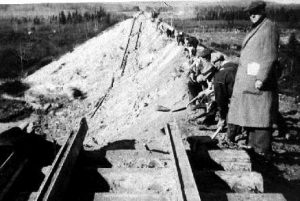 sparseness of the area’s population played a big part in the relative lack of major damage, despite the fact that it was a strong earthquake. The water of Tee Lake, close to the epicenter was discolored by the earthquake…due to a stirring up of gyttja, which is freshwater mud with abundant organic matter, rather than silt input from tributary streams. The relative lack of major damage, despite the fact that it was a strong earthquake, has been attributed primarily to the sparseness of the area’s population.
sparseness of the area’s population played a big part in the relative lack of major damage, despite the fact that it was a strong earthquake. The water of Tee Lake, close to the epicenter was discolored by the earthquake…due to a stirring up of gyttja, which is freshwater mud with abundant organic matter, rather than silt input from tributary streams. The relative lack of major damage, despite the fact that it was a strong earthquake, has been attributed primarily to the sparseness of the area’s population.
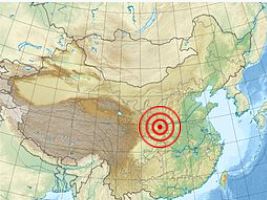 Most of us realize that there are earthquakes going on all the time. Most of them are very small, and often not even felt by anyone. Some are so far out in the ocean that they have little effect of anything. Others are far out in the wilderness or unpopulated areas, and so no one feels them. There are, however, some that are so large and so devastating, that they can never be forgotten. The January 23, 1556 earthquake in Shaanxi, China is just such an earthquake.
Most of us realize that there are earthquakes going on all the time. Most of them are very small, and often not even felt by anyone. Some are so far out in the ocean that they have little effect of anything. Others are far out in the wilderness or unpopulated areas, and so no one feels them. There are, however, some that are so large and so devastating, that they can never be forgotten. The January 23, 1556 earthquake in Shaanxi, China is just such an earthquake.
The earthquake struck Shaanxi late in the evening, and the aftershocks continuing through the following morning. I’m not sure how the scientists can calculate the magnitude years later, but their investigation revealed that the magnitude of the quake was approximately 8.0 to 8.3. That is, by no means, the strongest quake on record, but it struck right in the middle of a densely populated area with poorly constructed buildings and homes, resulting in a horrific death toll. Making buildings earthquake proof in the 1500s was not even a possibility…at least not to the level of the current building codes. Because of that, the death toll was estimated at a staggering 830,000 people. Of course, counting casualties is often imprecise after large-scale disasters, especially prior to the 20th century. Nevertheless, this disaster is still considered the deadliest of all time.
The earthquake’s epicenter was in the Wei River Valley in the Shaanxi Province, near the cities of Huaxian, 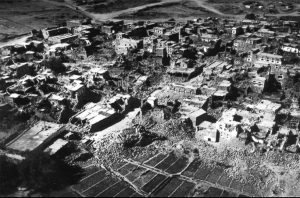 Weinan and Huayin. In Huaxian alone, every single building and home collapsed, killing more than half the residents of the city. The death toll there was estimated in the tens of thousands. Similarly, the death toll and economic impact in Weinan and Huayin was also very high. There were places where 60-foot-deep crevices opened in the earth. Serious destruction and death occurred as much as 300 miles away from the epicenter. The earthquake triggered landslides, which also contributed to the massive death toll. Of course, the estimates could be off, but even if the number of deaths caused by the Shaanxi earthquake has been overestimated slightly, it would still rank as the worst disaster in history by a considerable margin.
Weinan and Huayin. In Huaxian alone, every single building and home collapsed, killing more than half the residents of the city. The death toll there was estimated in the tens of thousands. Similarly, the death toll and economic impact in Weinan and Huayin was also very high. There were places where 60-foot-deep crevices opened in the earth. Serious destruction and death occurred as much as 300 miles away from the epicenter. The earthquake triggered landslides, which also contributed to the massive death toll. Of course, the estimates could be off, but even if the number of deaths caused by the Shaanxi earthquake has been overestimated slightly, it would still rank as the worst disaster in history by a considerable margin.
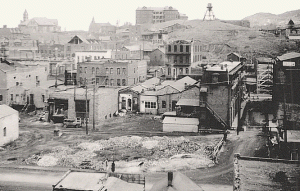 For many years my husband’s Aunt Marian and Uncle John Kanta lived in Helena, Montana. Some of their kids still do, but they didn’t live there in 1935, when on October 18th, a magnitude 6.2 earthquake struck at 10:48pm. The quake had its epicenter right near Helena and it had a maximum perceived intensity of VIII (Severe) on the Mercalli intensity scale. The quake on that date was the largest of a series of earthquakes that also included a large aftershock on October 31 of magnitude 6.0 and a maximum intensity of VIII. Two people died in the first quake, and two others died as a result of the October 31 aftershock. Property damage was over $4 million.
For many years my husband’s Aunt Marian and Uncle John Kanta lived in Helena, Montana. Some of their kids still do, but they didn’t live there in 1935, when on October 18th, a magnitude 6.2 earthquake struck at 10:48pm. The quake had its epicenter right near Helena and it had a maximum perceived intensity of VIII (Severe) on the Mercalli intensity scale. The quake on that date was the largest of a series of earthquakes that also included a large aftershock on October 31 of magnitude 6.0 and a maximum intensity of VIII. Two people died in the first quake, and two others died as a result of the October 31 aftershock. Property damage was over $4 million.
Helena is a pretty city that lies in a valley in western Montana. It lies within the northern part of the Intermountain Seismic Belt (ISB). I didn’t know it then, but this is an area of relatively intense seismicity. It runs from northwestern Arizona, through Utah, Idaho, and Wyoming, before dying out in northwestern Montana. In the area near Helena, it turns to the northwest, where it intersects with the Lewis and Clark fault zone. The Helena earthquake sequence actually began October 3, 1935, with a small earthquake. That quake was followed by a damaging earthquake on October 12th, a magnitude 5.9, intensity VII. That wasn’t the mainshock, however. That one occurred on October 18th, a magnitude 6.2, intensity VIII. A lesser shock followed on October 31st, a magnitude 6.0, intensity VIII, and a further large aftershock on November 28th, a magnitude 5.5, intensity VI. These were just the mainshocks. There were also a total of 1800 tremors recorded 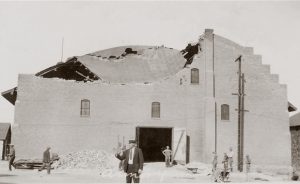 between October 4, 1935 and April 30, 1936. The people of Helena either got used to the shaking, which I can’t imagine, or they were terrified with every tremor, which makes more sense to me.
between October 4, 1935 and April 30, 1936. The people of Helena either got used to the shaking, which I can’t imagine, or they were terrified with every tremor, which makes more sense to me.
The damage to the unreinforced buildings of that era was widespread, with more than 200 chimneys destroyed in the city of Helena. At that time, little was known about reinforcement of buildings in earthquake prone areas. The northeast part of the city, where buildings were constructed on alluvial soil, and in the southern business district, which contained many brick buildings, saw the strongest effects. Alluvial soil is highly porous, which would explain the soil liquification that took place. The most extensively damaged building was the Helena High School, which was completed in August 1935 and had just been dedicated in early October. The school buildings, which had cost $500,000, had not been designed to be earthquake resistant. Another building that was totally destroyed and had to be rebuilt was the Lewis and Clark County Hospital. The October 18 earthquake caused an estimated $3 million of damage to property. The aftershock of October 31 caused further damage estimated at $1 million, particularly to structures already weakened by the October 18 shock. Two people were killed by falling bricks in Helena during the October 18 shock. Two brick masons died as while removing a brick tower during the October 31 aftershock.
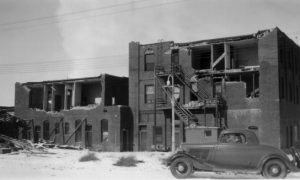 The Red Cross and Federal Emergency Relief Administration set up emergency camps for those displaced by the quake on land at the Montana Army National Guard’s Camp Cooney. Approximately 400 people stayed there the first night, but most had found space with friends or family outside of the damaged area by the end of the week. Some people were too afraid of continued shocks to stay in a house, and they stayed in tents for the next few weeks. The National Guard was deployed in Helena to keep sightseers away from the damaged buildings, and either because of the guard or the good moral values of the people, there was no looting. It is believed that in today’s world, the damages would have been in the $500 million range.
The Red Cross and Federal Emergency Relief Administration set up emergency camps for those displaced by the quake on land at the Montana Army National Guard’s Camp Cooney. Approximately 400 people stayed there the first night, but most had found space with friends or family outside of the damaged area by the end of the week. Some people were too afraid of continued shocks to stay in a house, and they stayed in tents for the next few weeks. The National Guard was deployed in Helena to keep sightseers away from the damaged buildings, and either because of the guard or the good moral values of the people, there was no looting. It is believed that in today’s world, the damages would have been in the $500 million range.
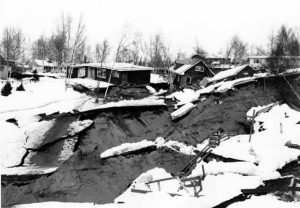
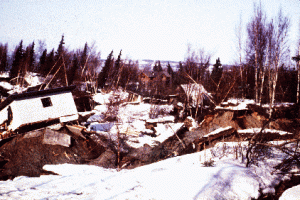 The earthquake struck at 5:35pm local time on Good Friday, March 27, 1964. Its epicenter was 12.4 miles north of Prince William Sound, 78 miles east of Anchorage and 40 miles west of Valdez. Across southcentral Alaska, ground fissures, collapsing structures, and tsunamis resulting from the earthquake caused about 131 deaths. Soil liquefaction, fissures, landslides, and other ground failures caused major structural damage in several communities and much damage to property. Anchorage was hit very hard, and sustained great destruction or damage to many inadequately earthquake-engineered houses, buildings, paved streets, sidewalks, water and sewer mains, electrical systems, and other man-made equipment, particularly in the several landslide zones along Knik Arm. Two hundred miles southwest, some areas near Kodiak were permanently raised by 30 feet. Southeast of Anchorage, areas around the head of Turnagain Arm near Girdwood and Portage dropped as much as 8 feet, requiring reconstruction and fill to raise the Seward Highway above the new high tide mark.
The earthquake struck at 5:35pm local time on Good Friday, March 27, 1964. Its epicenter was 12.4 miles north of Prince William Sound, 78 miles east of Anchorage and 40 miles west of Valdez. Across southcentral Alaska, ground fissures, collapsing structures, and tsunamis resulting from the earthquake caused about 131 deaths. Soil liquefaction, fissures, landslides, and other ground failures caused major structural damage in several communities and much damage to property. Anchorage was hit very hard, and sustained great destruction or damage to many inadequately earthquake-engineered houses, buildings, paved streets, sidewalks, water and sewer mains, electrical systems, and other man-made equipment, particularly in the several landslide zones along Knik Arm. Two hundred miles southwest, some areas near Kodiak were permanently raised by 30 feet. Southeast of Anchorage, areas around the head of Turnagain Arm near Girdwood and Portage dropped as much as 8 feet, requiring reconstruction and fill to raise the Seward Highway above the new high tide mark.
I came to know of this horrific 9.2 magnitude earthquake when my husband, Bob and I were on a cruise to Alaska. The cruise ended in Anchorage, and we had taken an extra day for exploration of the area. My first notice of this Alaskan earthquake was on a shuttle ride from the airport to Anchorage proper. We had the day before our flight at 10:30pm, so we stored our luggage at the airport and took the shuttle back into town. The shuttle driver took us by the Turnagain Heights neighborhood, the current location of Earthquake Park. She told us that the soil there had liquified and homes were swallowed…some almost completely, leaving only their chimneys above ground, while others were swept out to sea in the ensuing tsunami waves. I couldn’t shake the dreadful feeling of the horror that had happened there. A stop in a museum, including a documentary about the 1964 Alaskan earthquake, told me that the earthquake that happened in the modern-day Earthquake Park, was the 1964 Alaskan earthquake. Of course, I was only 8 years old when it happened, so I guess that it is not so odd that I hadn’t heard of it.
We began a much longer than expected walk along the Tony Knowles Coastal Bicycle Trail. Of course, people were walking on the trail too, but we had no idea how long the walk back to the airport would be. Nevertheless, the walk took us through Earthquake Park, and…well, I have only noticed such an air of heaviness in one other place…Gettysburg Battlefield. There is something about being in a place where so much death and destruction occurred. I takes on an air of being “hallowed ground” somehow. President Lincoln knew what he was talking about when he gave the Gettysburg Address. Walking through Earthquake Park, you could see the rippled ground, where the liquified soil had rolled back and forth during the earthquake. We didn’t get off the trail, so if there were chimneys visible near us, we didn’t see them, but I was moved to think that beneath our feet, there might be houses that people had lived in. I didn’t know if the people who had lived there were there still, or if 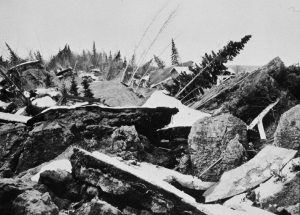
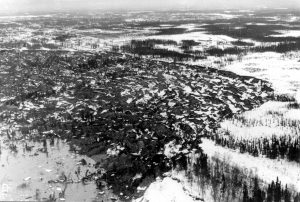 they had been located and buried after the disaster. Whatever the case may be, I left the area feeling very different than I had just two days earlier. I had been in the exact place where such a devastating disaster had happened, and I have never forgotten that place, just as I have never forgotten the feeling I felt at Gettysburg. Some things just have a profound effect on us…forever.
they had been located and buried after the disaster. Whatever the case may be, I left the area feeling very different than I had just two days earlier. I had been in the exact place where such a devastating disaster had happened, and I have never forgotten that place, just as I have never forgotten the feeling I felt at Gettysburg. Some things just have a profound effect on us…forever.
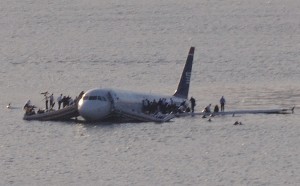 Imagine, if you can these days, a world without photography. Cameras are almost always at our fingertips now. We don’t need to carry a camera with us, we have our phones, and we are able to take all the pictures we want. We can document everything from the birth of our children, to a pretty sunset in the back yard. We document our smiles, frowns, and totally shocked looks. In so many ways, personal photography has changed our lives, but one way in particular is in documenting history. Most people don’t think our what they are doing as documenting history exactly, but it certainly can be. People have captured plane crashes, rocket launches, car accidents, forest fires, volcano eruptions, and earthquakes…just to name
Imagine, if you can these days, a world without photography. Cameras are almost always at our fingertips now. We don’t need to carry a camera with us, we have our phones, and we are able to take all the pictures we want. We can document everything from the birth of our children, to a pretty sunset in the back yard. We document our smiles, frowns, and totally shocked looks. In so many ways, personal photography has changed our lives, but one way in particular is in documenting history. Most people don’t think our what they are doing as documenting history exactly, but it certainly can be. People have captured plane crashes, rocket launches, car accidents, forest fires, volcano eruptions, and earthquakes…just to name 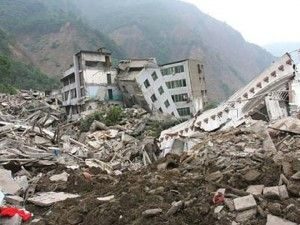 a few. Those things might not be history today, but in a couple of years, they are, and in many cases, one person had the only picture of the historic event.
a few. Those things might not be history today, but in a couple of years, they are, and in many cases, one person had the only picture of the historic event.
Would history be documented without photography? Of course, but it would happen by word of mouth, and later the written word…newspapers, books and such. The problem with that is that those accounts can only tell the part of history that someone saw or was a part of. But, what if they missed something? Humans so often miss the small details, but a camera or video camera, doesn’t miss as much. Once a picture is taken, an event is documented…and every small detail can be re-examined at will. Pictures have made the difference between knowing the cause and never knowing the cause. Pictures have proven fault 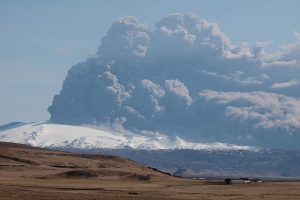 without a doubt. They have been the difference between an innocent person being falsely accused, and getting to the truth.
without a doubt. They have been the difference between an innocent person being falsely accused, and getting to the truth.
These days, with a camera built into our phone, we can, and do, document many events of our lives. And we document history…some of it amazing, and some of it devastating. It’s all part of the ability to capture things in real time. You have to take the bad with the good, because unfortunately, not all of history is beautiful. Some of it is completely ugly, but it still needs to be documented. Pictures have become necessary, because without photography, much of the full documentation of history would be lost.
 It seems that before every accepted type of warning system, there is a period of time when the warnings are either ignored by officials or the officials worry that such a warning will cause a panic among the people. In retrospect, however, the officials always wish that they had allowed the warnings to be posted, so that lives could have been saved. I can understand how the idea of mass panic could be a bit scary for officials, and people often don’t act in a way that could produce an orderly evacuation, in which everyone evacuates as if nothing is wrong.
It seems that before every accepted type of warning system, there is a period of time when the warnings are either ignored by officials or the officials worry that such a warning will cause a panic among the people. In retrospect, however, the officials always wish that they had allowed the warnings to be posted, so that lives could have been saved. I can understand how the idea of mass panic could be a bit scary for officials, and people often don’t act in a way that could produce an orderly evacuation, in which everyone evacuates as if nothing is wrong.
David Bernays and Charles Sawyer were two American scientists who were exploring the area around Yungay, Peru. They were climbing nearby Mount Huascarán, when they saw something that alarmed them. They noticed quite a bit of loose bedrock under a glacier. The scientists also knew that the region was prone to earthquakes. The mix of those two things, possible disasters on their own, could be catastrophic if they happened together. Bernays and Sawyer tried to save the residents of Yungay, Peru from the huge avalanche that was a very real possibility.
At the warning, the government became so outraged by the warning the scientists issued, that they ordered the them to take it back or go to prison. That was a big threat, and these were American scientists in a foreign country. I’m sure that the men were justifiably terrified. As a result of the threat and the fear it brought, the two scientists fled the country. Several years later, the men were proven right, when an avalanche killed most of Yungay’s 20,000 residents. I’m sure that being proven right didn’t do much for the two scientists’ feelings of horror at the very disaster that they had so correctly predicted. This was not going to be an “I told you so” moment. It was simply a tragedy…and it could have been prevented, if anyone had listened.
The May 31, 1970 undersea earthquake off the coast of Casma and Chimbote, north of Lima, triggered one of the most cataclysmic avalanches in recorded history. The avalanche wiped out the entire highland town of Yungay and most of its 25,000 inhabitants. Around 3:23pm, local time, while most people were tuned in to the Italy-Brazil FIFA World Cup Match, an earthquake struck the Peruvian departments of Ancash and La Libertad. The quake’s epicenter was located in the Pacific Ocean, where the Nazca Plate is subducted by the South American Plate, and recorded a magnitude of 8.0 on the Richter scale, with an intensity of up to 8 on the Mercalli scale. The quake lasted 45 seconds, and crumbled adobe homes, bridges, roads and schools across 83,000 square kilometers, an area larger than Belgium and the Netherlands combined. It was registered as one of the worst earthquakes ever to be experienced in South America. Damage and casualties were reported as far 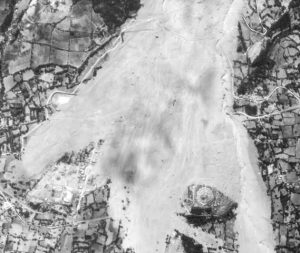 as Tumbes, Iquitos and Pisco, as well as in some parts of Ecuador and Brazil…but in Yungay, a small highland town in the picturesque Callejon de Huaylas, founded by Domingo Santo Tomás in 1540, the earthquake triggered an even greater calamity.
as Tumbes, Iquitos and Pisco, as well as in some parts of Ecuador and Brazil…but in Yungay, a small highland town in the picturesque Callejon de Huaylas, founded by Domingo Santo Tomás in 1540, the earthquake triggered an even greater calamity.
Following the quake, the glacier on the north face of Mount Huascarán broke free, causing 10 million cubic meters of rock, ice and snow to break away and tear down its slope at more than 120 miles, per hour. As it thundered down toward Yungay, and the town of Ranrahirca on the other side of the ridge, the wave of debris picked up more glacial deposits and began to spit out mud, dust, and boulders. By the time it reached the valley, just three minutes later, the 3,000 feet wide wave was estimated to have consisted of about 80 million cubic meters of ice, mud, and rocks. Within moments, what was Yungay and its 25,000 inhabitants, many of whom had rushed into the church to pray after the earthquake struck, were buried and crushed by the landslide. The smaller village of Ranrahirca was buried as well, the second time in a decade, but it is the image of lone surviving palm trees in the Yungay cemetery that is burned into Peru’s memory.
“We were on our way from Yungay to Caraz when the earthquake struck,” survivor Mateo Casaverde recalls. “When we stepped out of the car, the earthquake was almost over. Then we heard a deep, low rumble, something distinct from the noise an earthquake makes, but not too different. It came from the Huascarán. Then we saw, half-way between Yungay and the mountain, a giant cloud of dust. Part of the Huascarán was coming toward us. It was approximately 3:24pm. Where we were, the only place that offered us relative security, was the cemetery, built upon an artificial hill, like a pre-Incan tomb. We ran approximately 100 meters before we got to the cemetery. Once I reached the top, I turned to see Yungay. I could clearly see a giant wave of gray mud, about 60 meters high. Moments later, the landslide hit the cemetery, about five meters below our feet. The sky went dark because of all the dust, mostly from all of the destroyed homes. We turned to look, and Yungay, as well as its thousands of inhabitants, had completely disappeared.”
The reported death toll from what came to be known as Peru’s Great Earthquake totaled more than 74,000 people. About 25,600 were declared missing, over 143,000 were injured and more than one million left homeless. The city of Huaraz was rubble, the valley buried in mud, and coastal towns such as Casma were also shaken to the ground. In Yungay, only some 350 people survived, including the few who were able to climb to the town’s elevated step-like cemetery. Built between 1892 and 1903, the cemetery was designed by Swiss architect Arnoldo Ruska, who also died as a result of the landslide. Among the survivors were 300 children, who had been taken to the circus at the local stadium, set on higher ground and on the outskirts of the town.
 Today, Yungay is a national cemetery and the Huascarán’s victims are still vividly remembered. Because the Peruvian government has forbidden excavation in the area, crosses and tombs mark the spots where homes once stood, engraved with the names of those never found. A crushed intercity bus, four of the original palm trees that once crowned the city’s main plaza and remnants of the cathedral still stand. Though life goes on and a new Yungay has since been rebuilt, a few miles away from the original city, Peru does not forget. In 2000, in memory of the victims of the deadliest seismic disaster in the history of Latin America, the government declared May 31 “Natural Disaster Education and Reflection Day.”
Today, Yungay is a national cemetery and the Huascarán’s victims are still vividly remembered. Because the Peruvian government has forbidden excavation in the area, crosses and tombs mark the spots where homes once stood, engraved with the names of those never found. A crushed intercity bus, four of the original palm trees that once crowned the city’s main plaza and remnants of the cathedral still stand. Though life goes on and a new Yungay has since been rebuilt, a few miles away from the original city, Peru does not forget. In 2000, in memory of the victims of the deadliest seismic disaster in the history of Latin America, the government declared May 31 “Natural Disaster Education and Reflection Day.”
 Earthquakes can happen anywhere, but there are areas that are more prone to earthquakes than other areas. When we think about that, we think of Alaska, California, or Japan, all of which experience daily earthquakes. Of course, there are many other places that get a lot of earthquakes. One such place is in Italy. The area around Sicily and Calabria are known as la terra ballerina, “the dancing land,” for the periodic seismic activity that strikes the region. I would have thought that with 12,000 earthquakes a year in Alaska, or 10,000 earthquakes a year in California, or 1,500 earthquakes in Japan, that any of these places would be called “the dancing land” before the area of Sicily and Calabria, which doesn’t have nearly as many.
Earthquakes can happen anywhere, but there are areas that are more prone to earthquakes than other areas. When we think about that, we think of Alaska, California, or Japan, all of which experience daily earthquakes. Of course, there are many other places that get a lot of earthquakes. One such place is in Italy. The area around Sicily and Calabria are known as la terra ballerina, “the dancing land,” for the periodic seismic activity that strikes the region. I would have thought that with 12,000 earthquakes a year in Alaska, or 10,000 earthquakes a year in California, or 1,500 earthquakes in Japan, that any of these places would be called “the dancing land” before the area of Sicily and Calabria, which doesn’t have nearly as many.
Nevertheless, the name was given and it stuck. While it may not have as many, the ones that hit there seem to be especially devastating. In 1693, 60,000 people were killed in southern Sicily by an earthquake, and in 1783 most of the Tyrrenian coast of Calabria was leveled by a massive earthquake that 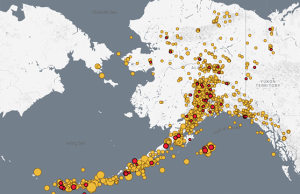 killed 50,000. The quake of 1908 was particularly costly in terms of human life because it struck at at dawn, catching most people at home in bed rather than in the relative safety of the streets or fields. The December 28, 1908 earthquake which struck at 5:20am was the most destructive earthquake in recorded European history strikes the Straits of Messina in southern Italy. The cities of Messina in Sicily and Reggio di Calabria on the Italian mainland were leveled by the devastating quake. The earthquake and tsunami it caused killed an estimated 100,000 people. The main shock registered an estimated 7.5 magnitude on the Richter scale. It caused a devastating tsunami with 40-foot waves that washed over coastal towns and cities. The two major cities on either side of the Messina Straits–Messina and Reggio di Calabria, had about 90 percent of their buildings destroyed. The quake cut telegraph lines and damaged railway lines, seriously slowing down the relief efforts. To make matters worse, many of the remaining buildings were destroyed by hundreds of smaller
killed 50,000. The quake of 1908 was particularly costly in terms of human life because it struck at at dawn, catching most people at home in bed rather than in the relative safety of the streets or fields. The December 28, 1908 earthquake which struck at 5:20am was the most destructive earthquake in recorded European history strikes the Straits of Messina in southern Italy. The cities of Messina in Sicily and Reggio di Calabria on the Italian mainland were leveled by the devastating quake. The earthquake and tsunami it caused killed an estimated 100,000 people. The main shock registered an estimated 7.5 magnitude on the Richter scale. It caused a devastating tsunami with 40-foot waves that washed over coastal towns and cities. The two major cities on either side of the Messina Straits–Messina and Reggio di Calabria, had about 90 percent of their buildings destroyed. The quake cut telegraph lines and damaged railway lines, seriously slowing down the relief efforts. To make matters worse, many of the remaining buildings were destroyed by hundreds of smaller 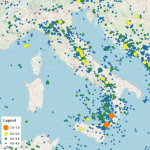 tremors over subsequent days. These tremors injured or killed rescuers. On December 30, King Victor Emmanuel III arrived aboard the battleship Napoli to inspect the devastation.
tremors over subsequent days. These tremors injured or killed rescuers. On December 30, King Victor Emmanuel III arrived aboard the battleship Napoli to inspect the devastation.
To make matters worse, a steady rain fell on the ruined cities, forcing the dazed and injured survivors, clad only in their nightclothes, to take shelter in caves, grottoes, and impromptu shacks built out of materials salvaged from the collapsed buildings. Veteran sailors could barely recognize the shoreline because long stretches of the coast had sunk several feet into the Messina Strait. The devastation was horrific. After all that, I can see why it is called la terra ballerina, “the dancing land.”
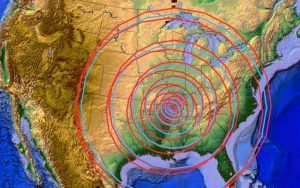 After an earthquake, especially a big quake, you start looking for damage or reports of damage. You will invariably find damage, unless the quake occurred in an area that is completely unsettled or in the ocean. Still, you have to look well beyond the epicenter of the quake…sometimes as far away as 6,000 miles. A big quake can shake things up for many miles. On December 16, 1811 a series of Intraplate earthquakes began, that shook apart the area of the New Madrid fault in present day Missouri, around the Mississippi River. Intraplate earthquakes are often confused with Interplate earthquakes, but are fundamentally different in origin, occurring within a single plate rather than between two tectonic plates on a plate boundary, like the Interplate earthquake does. The specifics of the mechanics by which they occur, as well as the intensity of the stress drop which occurs after the earthquake also differentiate the two types of events. Intraplate earthquakes have, on average, a higher stress drop than that of an Interplate earthquake and generally higher intensity,meaning they can bring more damage. These Intraplate earthquakes continued until February 7, 1812. The first earthquake on December 16th had its epicenter in northeast Arkansas and measured up to an 8 on the Mercalli intensity scale. This earthquake was followed by another six hours later, and two more on January 23rd and February 7th, respectively. The third quake caused warping, magma eruptions, fissuring and landslides. While these were unusual events for the area, the were far from the most unusual events related to this series of quakes.
After an earthquake, especially a big quake, you start looking for damage or reports of damage. You will invariably find damage, unless the quake occurred in an area that is completely unsettled or in the ocean. Still, you have to look well beyond the epicenter of the quake…sometimes as far away as 6,000 miles. A big quake can shake things up for many miles. On December 16, 1811 a series of Intraplate earthquakes began, that shook apart the area of the New Madrid fault in present day Missouri, around the Mississippi River. Intraplate earthquakes are often confused with Interplate earthquakes, but are fundamentally different in origin, occurring within a single plate rather than between two tectonic plates on a plate boundary, like the Interplate earthquake does. The specifics of the mechanics by which they occur, as well as the intensity of the stress drop which occurs after the earthquake also differentiate the two types of events. Intraplate earthquakes have, on average, a higher stress drop than that of an Interplate earthquake and generally higher intensity,meaning they can bring more damage. These Intraplate earthquakes continued until February 7, 1812. The first earthquake on December 16th had its epicenter in northeast Arkansas and measured up to an 8 on the Mercalli intensity scale. This earthquake was followed by another six hours later, and two more on January 23rd and February 7th, respectively. The third quake caused warping, magma eruptions, fissuring and landslides. While these were unusual events for the area, the were far from the most unusual events related to this series of quakes.
After the February earthquake, it was reported that the Mississippi River began running backwards, and event that lasted for several hours and caused two temporary waterfalls to develop. The upthrusting of land caused the formation of Reelfoot Lake 15 miles south of the epicenter while the crushing of quartz crystals underground created flashing lights that lit up the sky. Boatmen on flatboats actually survived this experience and lived to tell the tale. Incredibly, the earthquakes could be felt over 50,000 square miles. That is shocking when you think about the fact that the 1906 San Francisco earthquake, which was deadly enough in its own right, was felt over 6,000 square miles.
The New Madrid earthquakes were the biggest earthquakes in American history. While they occurred in the 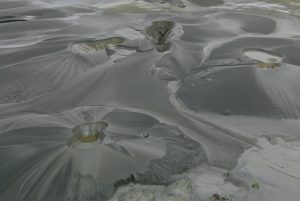 central Mississippi Valley, they were felt as far away as New York City, Boston, Montreal, and Washington D.C. President James Madison and his wife Dolly even felt them in the White House, and church bells rang in Boston. From December 16, 1811 through March of 1812 there were over 2,000 smaller earthquakes in the central Midwest, and between 6,000-10,000 earthquakes in the Bootheel of Missouri where New Madrid is located near the junction of the Ohio and Mississippi Rivers. In the known history of the world, no other earthquakes have lasted so long or produced so much evidence of damage as the New Madrid earthquakes. Three of the earthquakes are on the list of America’s top earthquakes: the first one on December 16, 1811, a magnitude of 8.1 on the Richter scale; the second on January 23, 1812, at 7.8; and the third on February 7, 1812, at as much as 8.8 magnitude.
central Mississippi Valley, they were felt as far away as New York City, Boston, Montreal, and Washington D.C. President James Madison and his wife Dolly even felt them in the White House, and church bells rang in Boston. From December 16, 1811 through March of 1812 there were over 2,000 smaller earthquakes in the central Midwest, and between 6,000-10,000 earthquakes in the Bootheel of Missouri where New Madrid is located near the junction of the Ohio and Mississippi Rivers. In the known history of the world, no other earthquakes have lasted so long or produced so much evidence of damage as the New Madrid earthquakes. Three of the earthquakes are on the list of America’s top earthquakes: the first one on December 16, 1811, a magnitude of 8.1 on the Richter scale; the second on January 23, 1812, at 7.8; and the third on February 7, 1812, at as much as 8.8 magnitude.
In addition to the Mississippi River running backwards, there were numerous other strange happenings too. As the area experienced more than 2,000 earthquakes in five months, people learned that most of the crevices opening up during an earthquake ran from north to south, so when the earth began moving, they would chop down trees in an east-west direction and hold on using the tree as a bridge. Unfortunately, there were also “missing people” who were most likely swallowed up by the earth. Some earthquake fissures were as long as five miles. Another strange event, though not totally unusual was the sand boils that formed. A sand boil is sand and water that come out onto the ground surface during an earthquake as a result of liquefaction at shallow depth. The world’s largest sand boil was created by the New Madrid earthquake. It is 1.4 miles long and 136 acres in extent, located in the Bootheel of Missouri, about eight miles west of Hayti, Missouri. Locals call it “The Beach.” Other, much smaller, sand boils were also found throughout the area. Small pellets up to golf ball sized tar balls were found in sand boils and fissures. Known as Seismic Tar Balls, they are petroleum that has been solidified, or “petroliferous nodules.” Lights flashed from the ground, caused by quartz crystals being squeezed. Generally known as Earthquake Lights, the phenomena is scientifically called “seismoluminescence.”
Water thrown up by an earthquake was lukewarm. It is speculated that the shaking caused the water to heat up and/or quartz light heated the water. The skies turned dark during the earthquakes, so dark that lighted lamps didn’t help. The air smelled bad, and it was hard to breathe. It is speculated that it was smog containing 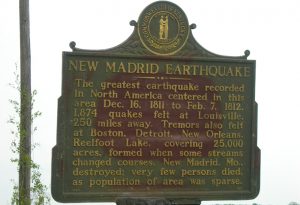 dust particles caused by the eruption of warm water into cold air. Sounds of distant thunder and loud explosions accompanied the earthquakes. People reported strange behavior by animals before the earthquakes. They were nervous and excited. Domestic animals became wild, and wild animals became tame. Snakes came out of the ground from hibernation. Flocks of ducks and geese landed near people. I’m sure that some of these events could be viewed as normal during n earthquake, but certainly some of them or even the mere numbers of these phenomena could be viewed as very strange, and I don’t know that there has ever been a more strange earthquake before or since.
dust particles caused by the eruption of warm water into cold air. Sounds of distant thunder and loud explosions accompanied the earthquakes. People reported strange behavior by animals before the earthquakes. They were nervous and excited. Domestic animals became wild, and wild animals became tame. Snakes came out of the ground from hibernation. Flocks of ducks and geese landed near people. I’m sure that some of these events could be viewed as normal during n earthquake, but certainly some of them or even the mere numbers of these phenomena could be viewed as very strange, and I don’t know that there has ever been a more strange earthquake before or since.

